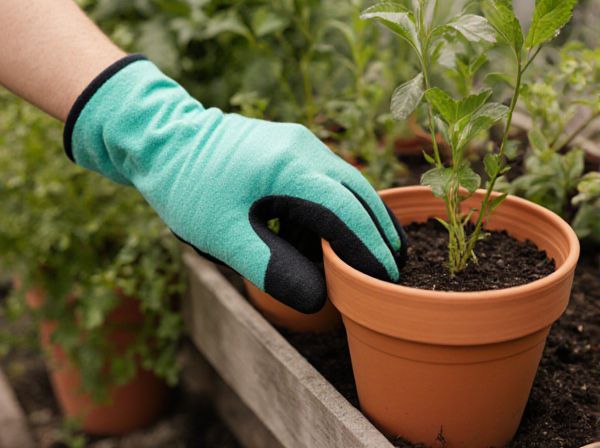
Fabric pots vs rigid containers Illustration
Fabric pots provide superior aeration and drainage compared to rigid containers, promoting healthier root growth and preventing root circling. Their flexible material allows for easier storage and transportation, making them ideal for gardeners with limited space. Rigid containers, however, offer greater durability and structural support, making them suitable for heavier plants and long-term use.
Table of Comparison
| Feature | Fabric Pots | Rigid Containers |
|---|---|---|
| Material | Breathable fabric (polyester, felt) | Plastic, ceramic, metal |
| Drainage | Excellent air and water drainage | Depends on holes; often limited drainage |
| Root Health | Prevents root circling, promotes air pruning | Potential root circling and compaction |
| Weight | Lightweight and portable | Generally heavier, less portable |
| Durability | Durable but can degrade under UV exposure | Highly durable, resistant to UV and impact |
| Temperature Regulation | Better airflow, reduces soil overheating | Less airflow, soil can heat up faster |
| Cost | Moderate to low cost | Varies; can be inexpensive to costly |
| Storage | Collapsible and easy to store | Rigid, bulky storage |
| Use Cases | Ideal for vegetables, herbs, and root crops | Suitable for decorative plants and orchids |
Introduction: Fabric Pots vs Rigid Containers
Fabric pots offer superior aeration and drainage compared to rigid containers, promoting healthier root development and preventing waterlogging. Unlike rigid containers, fabric pots allow air pruning of roots, leading to a more fibrous root system that enhances nutrient uptake. These breathable containers also reduce the risk of root circling and provide better temperature regulation for plants.
Material Differences and Design
Fabric pots use breathable, porous materials like non-woven polypropylene that promote air pruning and superior root aeration, preventing root circling and enhancing plant health. Rigid containers are typically made from plastic, ceramic, or metal, providing structural stability and moisture retention but limited airflow to roots. The flexible design of fabric pots allows for easier drainage and temperature regulation, while rigid containers offer durability and aesthetic options for long-term use.
Aeration and Root Health
Fabric pots offer superior aeration compared to rigid containers, promoting healthier root systems by preventing waterlogging and encouraging air pruning of roots. Enhanced oxygen flow in fabric pots stimulates robust root growth, reducing root circling and improving nutrient uptake efficiency. In contrast, rigid containers often restrict airflow, leading to compacted soil and a higher risk of root rot.
Drainage Capabilities
Fabric pots offer superior drainage capabilities due to their breathable, porous material that allows excess water to escape easily, preventing root rot and overwatering. In contrast, rigid containers often rely on drilled holes for drainage, which can sometimes be insufficient or lead to waterlogging if not properly managed. Enhanced airflow in fabric pots promotes healthier root systems by maintaining optimal moisture levels and avoiding stagnant water buildup.
Mobility and Versatility
Fabric pots offer superior mobility due to their lightweight and flexible design, making them easy to move and reposition even when filled with soil and plants. Rigid containers, while providing sturdy support, tend to be heavier and less adaptable in terms of shape and storage, limiting their versatility for different gardening spaces. The collapsible nature of fabric pots allows for convenient storage and transport, enhancing their practicality for gardeners seeking adaptability and ease of use.
Durability and Longevity
Fabric pots offer superior breathability and root aeration but typically have a shorter lifespan due to UV degradation and physical wear. Rigid containers, often made from plastic or resin, provide enhanced durability and longevity, enduring harsh weather conditions and repeated use without structural loss. For long-term gardening projects, rigid containers remain the preferred choice due to their resilience and longevity.
Temperature Regulation
Fabric pots enhance temperature regulation by allowing air circulation through their breathable material, reducing root overheating compared to rigid containers. Rigid containers tend to retain heat, causing soil temperatures to rise, which can stress plants during hot weather. The improved aeration in fabric pots helps maintain a cooler root zone, supporting healthier plant growth.
Suitability for Different Plant Types
Fabric pots provide excellent aeration and drainage, making them ideal for root vegetables, herbs, and plants requiring well-drained soil. Rigid containers retain moisture better and support heavier plants like tomatoes and shrubs that need stable root environments. Selecting the right container depends on the plant's growth habits, root structure, and moisture requirements.
Maintenance and Cleaning
Fabric pots require less maintenance as they are lightweight, breathable, and promote air pruning, reducing root problems. Rigid containers need regular cleaning to prevent algae buildup and root rot, often requiring more effort to sanitize. Both types benefit from periodic washing, but fabric pots can often be rinsed and air-dried quickly, enhancing overall ease of upkeep.
Cost and Environmental Impact
Fabric pots typically cost less than rigid containers due to lower material and manufacturing expenses, making them an economical choice for gardeners. Their breathable fabric promotes healthier root growth and reduces plastic waste, resulting in a smaller environmental footprint compared to rigid plastic containers. Unlike rigid containers, fabric pots are often reusable, biodegradable, and easier to recycle, supporting sustainable gardening practices.
Fabric pots vs rigid containers Infographic

 gardendif.com
gardendif.com